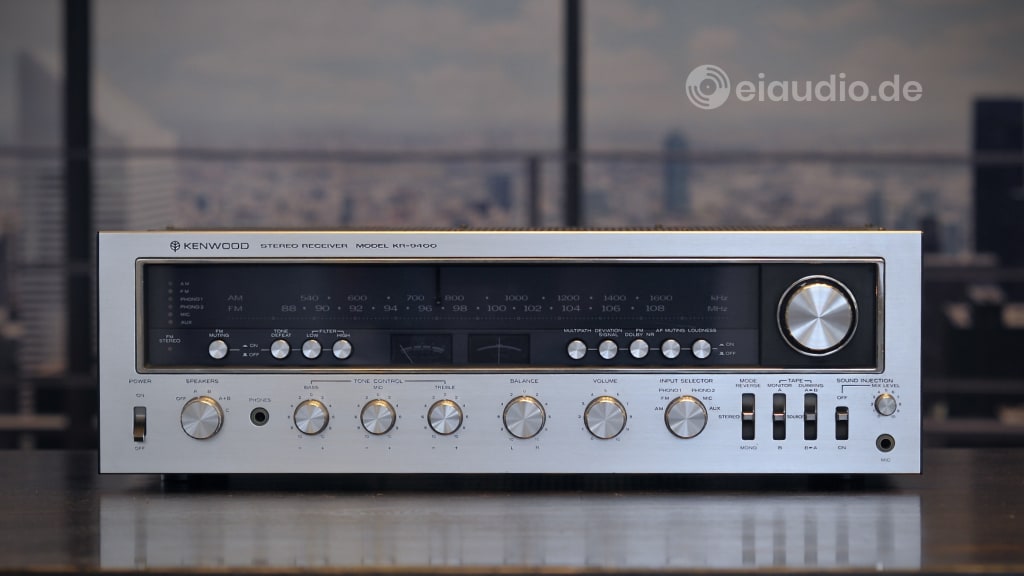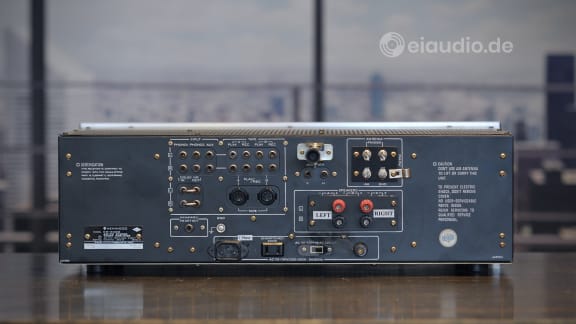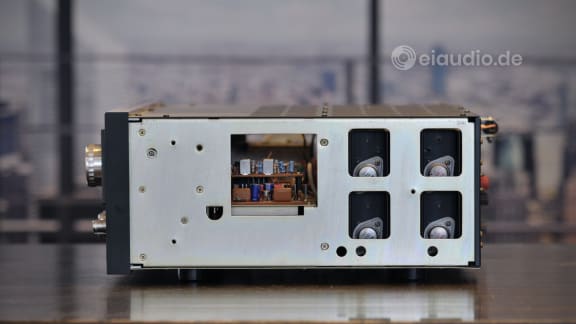Kenwood KR-9400
07/07/2022
Author: Karsten Hein
Category: Gear & Review
Tag(s): Receivers
The Kenwood KR-9400 was the third receiver presented in this blog. It was given to me for testing by Luigi, who had previously purchased it from a collector in Berlin. At the time it was handed to me, the Kenwood had already been fully serviced and technically restored where necessary. Due to some obscure event, however, this receiver had lost its original wooden sides. The wood applications would not only have looked nicer and potentially prevented children from reaching inside, but they would also have served to absorb some of the mechanical vibrations, e.g., from the extra-large transformer. Rebuilding the unit's American walnut flanks at first seemed like an attractive idea, but I soon found that it would take some professional support because of the sheer size of each of the two surfaces. After all, the Kenwood KR-9400 was a very large receiver, a fact that partly remained concealed because the overall proportions seemed natural enough.
Taking a first glance under the hood, I could see that some effort had gone into designing the power supply. Where Harman Kardon had taken the path of separate power supplies (one for each channel of their HK 630 and 730 receivers) both the Pioneer SX 850 and the Kenwood KR-9400 had to draw their energy from a single supply. On the Kenwood, the transformer and filter capacitors were of impressive size in order to allow for an effortless flow in music, even when playing in combination with more challenging speakers. And, in true power amplifier fashion, the two amplifier circuit boards were placed upright, directly to the left and to the right of the large power supply. Two over-sized heat sinks successfully kept the four NEC 2SD287 bi-polar transistors per channel cool through all operating conditions. NEC 2SD287-type transistors were considered run-of-the-mill power transistors and would ensure long performance and serviceability.
Similar to Hafler amp designs, the KR-9400 did not use coupling capacitors that would prevent direct current from reaching the output stage. This sort of concept could potentially kill speakers, but audiophiles tended to describe direct-coupled amplifiers as sounding more direct and revealing, possibly due to having one less part in the signal path. Given the time of its production, this Kenwood receiver did produce a relatively low level of total harmonic distortion and was rated at less than 0.1%. Its output power was class-leading and unrivalled in the world of receivers until 1974. In fact, its sheer power is sometimes said to have spawned the Receiver Wars. After all, 120 watts RMS per channel into an 8 Ohm load, and 150 WPC into 4 Ohms made this receiver a truly versatile companion to power most available speaker concepts and a rival even to separate pre and amplifier combos.
The KR-9400 was the most powerful receiver of Kenwood’s 400 range. Beginning from the pretty KR-1400, Kenwood's lowest-powered receiver with 10 WPC at 8 Ohms, the company counted up the first digit of their receiver names to reach the model that is presented here. I did find references to all the receiver models from one to nine online, with the exception of the KR-8400, which seemed to have been sold in small numbers to customers in North America only and had since become rare. But the number scheme did not only pertain to amplifier power. Higher numbers also stood for increased connectivity, along with lots of useful features. This might come as a surprise to audiophile listeners today, who are so used to being sold little more than the bare necessities at the higher echelons of the market. By modern theory, musicality and purity are sacrificed when there is more than a power button and volume control on board. But, after listening to the Kenwood KR-9400 extensively, I was starting to have my doubts about the validity of such claims.
I set the KR-9400 up in our upstairs listening room, where it was to compete with a duet consisting of Restek V1 preamplifier and Dynavox VR-70 tube amplifier. The speakers were still our formidable Epicure EPI 500, of 4 Ohms resistance and built from 1973 to 1981. It was not unlikely that the paths of these two legends should have previously crossed in some Higher-Fi household. I liked the idea of making this encounter possible once again. In our summer-heated upstairs apartment, most amplifiers had a tendency of overheating. — Not so the KR-9400. Even after hours of performing at higher or lower volume, the unit's surface temperature never rose above 40 degrees. This was not bad at all, especially for a combined unit that had lots of clean power to offer. Heat could be an issue with MOSFET and tube amplifiers, and the KR-9400 was neither.
The most obvious strength of the Kenwood was its ability to produce natural bass and not the intellectual bass that we had all come to accept as linear, truthful, etc. No, it was rather the kind of bass that was present in all natural events but that microphones and studios were unable to capture well. And this is not to say that the KR-9400's bass was in any way too much, overpowering, imprecise, or smothering. A fact that was hard to believe, as I had been taught to distrust the engulfing presence of bass. Supposedly, it was not 'linear' or unfit for audiophile listening. And reading these lines in an article by another blogger, I might still have my doubts. But with the KR-9400, bass was an asset and did not come across as fake or nonlinear at all. This impression was aided by a sufficient amount of layering and exceptional speed.
When I listened to the Kenwood play music for the first time, I wrote to Luigi that I could not believe the speed with which it presented the music. It almost felt overly eager to tell the whole story, as if it all had to come out at once. After a few minutes of listening, this early impression of shock changed into genuine admiration for a machine that obviously had great potential in terms of dynamics, rhythm, and speed. Although I first began with Jazz albums, as usual, I soon found myself exploring different genres to see how the increased speed would affect the music. I was pleasantly surprised by the agility of our EPI 500 speakers that now seemed to be more nimble on their feet than was usual with our other equipment. In Hi-Fi listening, bass-slam and speed were often mutually exclusive. This was not at all the case on the KR-9400 that made bass and speed appear to be natural and effortless occurrences.
And yet, there was another contradiction that the top-of-the-line Kenwood managed to overcome. In Hi-Fi, we naturally assumed that excessive bass would negatively affect our ability to detect nuances in the mid-band or treble. Since humans only had a single eardrum to handle all frequencies of music, greater excitement of the lower frequencies had the potential of smothering over the more delicate upper frequencies via the single diaphragm. Yet, somehow, this did not seem to be an issue while listening to the KR-9400. I admit that this positive impression may have been supported by our spacious listening room, in which our actual listening set-up occupied less than one fourth of the available space. Since there were no parallel walls, reflections were naturally kept to a minimum. In this scenario, bass frequencies were not at all in conflict with those produced by the midrange or treble. In a boxy room, on the other hand, the amount of bass attack might have led to a different assessment.
The KR-9400 offered two Phono inputs for MM cartridges with excellent sensitivity and highly accurate RIAA correction. The phono inputs shared a single ground screw which could make changing the connections a bit iffy. The AM/FM tuner section was of excellent quality and considered to be above the Marantz models of the period. There was one Auxiliary input to connect a CD-player or streamer, as well as a 6.3mm Microphone jack that was located on the front panel. Microphone input could be added to the music source by turning on the 'Sound Injection' function, and the microphone level could be adjusted to suit the general volume level. Two tape loops were available via separate switches. Recording from one tape to another was possible even while listening to a different music source in the process.
There were separate connectors for a Dolby Noise Reduction unit called the Kenwood KF-8011 'De-Noiser' and for an oscillator unit called the Kenwood KC-6060 A. Another convenient feature was the 6.3mm Headphone jack. Tone controls for Bass, Midrange, and Treble allowed for basic room correction, and a Tone Defeat button made sure that the signal path stayed untouched by such obstacles to the signal if needed. Additional High and Low Filters as well as a button for Loudness served to complete the extensive control package. All controls and switches were of very high quality with volume attenuator offering 40 steps that clicked into place on each turn. Everything about this receiver showed that cost considerations were last on Kenwood's list when building their flagship model.
The active signal source was indicated by an LED light on the left side of the large tuner scale, and another LED served to indicate if Stereo reception was possible. The LEDs made it possible to check basic settings from a distance. I did not so much appreciate the fact that the volume control was of the same design and perched between the Balance and the Input Selector. This would make it more difficult for casual users to operate the receiver with confidence, especially in low light conditions. As was typical for receivers of this period, playing music from a (high output) CD source made the volume attenuator very sensitive. Even with our EPI 500 speakers that were rated at 88dB, full listening volume was reached with the attenuator set in 9 o'clock position.
To close off my listening sessions, I put on Boris Blank's album 'Convergence'. First released in 2014, and with its strong focus on collected samples and computer generated sounds, the album was quite different from the albums found in the 1970s. To my delight, the KR-9400 presented Mr Blank's songs in a joyful, harmonically rich, and forward-sounding fashion with a lush midrange, full bass, and a slightly grainy but sweet-sounding treble. Kenwood clearly had produced a powerful and lively sounding receiver that would work well with many genres of music. Although the KR-9400 did not put its main focus on presenting the subtleties of music, there was still plenty of nuance to satisfy that end of the market. Instead, it excelled in speed and bass-slam. This certainly brought the aspect of joy back into the music. I could easily see myself listening to this receiver for hours on end and would personally give it preference over the two models I had previously tested.
Specifications
- Type: Post-WW2 AM/FM-receiver
- Tuning range: AM, FM
- Power output (8 Ohms): 2x 120 watts
- Power output (4 Ohms): 2x 150 watts
- Frequency response: 5 Hz to 40.000 Hz
- Total harmonic distortion: > 0.1%
- Damping factor: > 50 (8 Ohms)
- Speaker impedance: 4 to 16 Ohms
- Inputs: 2x Phono, 2x Tape, 1x Aux, 1x Mic, 1x Dolby NR
- Input sensitivity, line: 150mV
- Mic sensitivity: 2.5mV
- Phono sensitivity: 2.5mV for MM
- DIN sensitivity: 150mV
- Signal to noise ratios: 65dB (mic), 70dB (mm), 93dB (line/DIN)
- Tone controls (+/-10dB): 100 Hz, 800 Hz, 10.000 Hz
- Loudness (+5/+8 dB): 100 Hz, 10.000 Hz
- High filter (-5 dB): 10.000 Hz
- Low filter (-8 dB): 100 Hz
- Tone control bypass: bypass-defeat
- Outputs: 2x Tape, FM quad radial, 6.3mm headphone jack
- Line Output: 150mV (line), 30mV (din)
- Power consumption: 750 watts (max.)
- Dimensions: (W) 557 x (H) 166 x (D) 395 mm
- Weight: 20.6 kg
- Country of manufacture: Japan
- Year: 1974-1976
Accessories
- Oscilator: Kenwood KC-6060 A
- Noise reduction: Kenwood KF-8011 (de-noiser)





